
|
![]()
Greatest Films of the 1960s
1960 | 1961 | 1962 | 1963 | 1964 | 1965 | 1966 | 1967 | 1968 | 1969
Title Screen Film Genre(s), Title, Year, (Country), Length, Director, Description 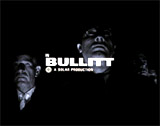



Bullitt (1968), 113 minutes, D: Peter Yates
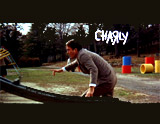

Charly (1968), 103 minutes, D: Ralph Nelson

Faces (1968), 130 minutes, D: John Cassavetes


Flesh (1968) (aka Andy Warhol's Flesh), 90 minutes, D: Paul Morrissey


Funny Girl (1968), 151 minutes, D: William Wyler




If... (1968, UK), 110 minutes, D: Lindsay Anderson



The Lion in Winter (1968, UK), 134 minutes, D: Anthony Harvey
An historical, dramatic tale of dysfunctional family intrigue set in the court of British King Henry II (Peter O'Toole) in 1183, from James Goldman's sharply written screenplay (adapted from his own play). Ten years earlier, Henry II had imprisoned his wife, Queen Eleanor of Aquitaine (Katharine Hepburn, who won her third of four acting Oscars), as punishment for helping precipitate a civil war against him. His three treacherous sons who are also vying for the British throne consist of the eldest, the legendary and fiery Prince Richard the Lionhearted (Anthony Hopkins in his film debut), the quiet but dangerous middle son Prince Geoffrey (John Castle), and the youngest, the manipulative and thieving scoundrel Prince John (Nigel Terry). The three sons and estranged wife Eleanor are summoned by Henry to the castle for a Christmas family reunion in Chinon, France. He has decided to name one of his three sons as his heir to the throne. Adding to the intrigue and plotting of who will be favored (Henry favors John, while Eleanor favors Richard), the teenaged but cunning monarch King Philip II of France (Timothy Dalton in his film debut) is also invited, with his older sister Princess Alais (Jane Merrow) - Henry's mistress. The film shines with the performances and dialogue between the two leads: 36-year old O'Toole as the 50 year-old monarch, and 61 year-old Hepburn as his younger wife.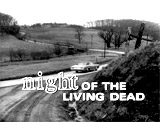


Night of the Living Dead (1968), 90 minutes, D: George Romero
One of the most important and influential horror films of all time - George Romero's ultra-low budget debut film shot in grainy black-and-white with an unknown cast reinvented the genre. The film was actually improved by its crude "drawbacks," since they lent a documentary feel and reality that made the film all the more horrific. The screenplay was taken from an unpublished short story Romero had written called Anubis, so-named after the Egyptian god of the dead. In the simple yet brutally relentless plot of claustrophobic horror, the 'living dead' (re-animated corpses) mysteriously rise from the grave for no known reason (though there are vague references to radiation from a fallen satellite), forcing a group of seven strangers to take refuge from the shuffling, hungry, flesh-eating zombies in an isolated Pennsylvania farmhouse. A capable, smart and sympathetic black man (Duane Jones) assumes leadership as the army of corpses repeatedly try to enter the house during a terrifying siege, amidst both unspoken racial and generational tensions between him and a less capable, older white family man (Hardman). The images of the film are haunting, from the opening scene in the cemetery, where flighty female lead Barbra (Judith O'Dea) is teased by her brother Johnny (Russell Streiner in an uncredited role): "They're coming to get you, Barbra!" before being attacked by one of them, to the shot of the zombified little girl consuming her mother (often taken to be a social metaphor for the late 1960s youth of the nation rebelling against their elders). Meanwhile, news and radio reports from the mass media emphasize the panic and threat. The tragic ending comes from the actions of real mindless zombies -- living lynch mobs. While initially considered drive-in schlock, the film gained in popularity and critical respect, and raised Romero to great heights as a horror filmmaker. He would go on to make a zombie trilogy with the successful Dawn of the Dead (1978) and the lesser Day of the Dead (1985) - and more.


Oliver! (1968, UK), 153 minutes, D: Carol Reed
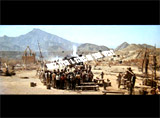

Once Upon a Time in the West (1968, It./US) (aka C'era Una Volta Il West), 165 minutes, D: Sergio Leone
This was director Leone's true western epic masterpiece - a revisionistic revenge western filmed in John Ford's favored location, Monument Valley, and in Spain. It featured a great musical score (and harmonica melody) by Ennio Morricone, and told about the coming of the railroad and the struggle between various groups for monopolistic control - with numerous instances of homage to earlier traditional Hollywood westerns. And it also brought together all the themes, characterizations, and experimental visuals from his own previous three films - the successful "spaghetti western" trio of films from 1964 to 1966 starring Clint Eastwood as "The Man With No Name." Its widescreen opening sequence has been justly celebrated - a tense, detailed, almost-wordless standoff at noon in the midday sun between three hired gunmen (Snaky (Jack Elam), Stony (Woody Strode), and Knuckles (Al Mulock)) at a train station, marked by only exaggerated sound effects, wide closeups, and the arrival of the train with a harmonica-playing killer named "Harmonica" (Charles Bronson). The plot was about a beautiful widow, reformed ex-New Orleans prostitute Jill McBain (Claudia Cardinale), who arrived at her Sweetwater homestead in the desert - a key location where trains crossing the continent would have to stop for water. Just before her arrival, her new husband, local Irish businessman Brett McBain (Frank Wolff) and his three children had just been massacred (due to a railroad dispute) - it was a cold-blooded and merciless ambush and murder led by blue-eyed, black-hatted, railroad company employee Frank (American icon-actor Henry Fonda in an about-face role as a villainous, sadistic murderer). Frank was taking orders from sickly, crippled and corrupt railroad tycoon Morton, aka "Mr. Choo Choo" (Gabriele Ferzetti). The McBain murders were set up to blame honorable yet grizzled escaped con and half-breed, wily scoundrel Cheyenne (Jason Robards). Jill received help from the mysterious harmonica-playing stranger and protector/escaped con Cheyenne after the brutal killings, to thwart efforts of others to take her inherited strategic plot of land. The film concluded with a classic confrontational ending - a showdown duel between Harmonica and Frank, that revealed (in a fateful, revelatory flashback) the reason for Harmonica's life-long search for revenge against Frank. In the final sequence, a mortally-wounded Cheyenne (earlier he had been shot in the abdomen during Cheyenne's rescue) spoke his final words to Harmonica, who then rode away (with a second horse carrying the slumped-over corpse of Cheyenne). Meanwhile, Jill confidently strode to the Sweetwater railway station to offer water to the laborers and track-laying crews before the end credits began to roll.



Petulia (1968, UK), 105 minutes, D: Richard Lester


Planet of the Apes (1968), 112 minutes, D: Franklin Schaffner
A thought-provoking and engrossing science-fiction film classic - a loose adaptation (by formerly blacklisted Michael Wilson and Rod Serling) of the Pierre Boulle novel La Planète Des Singes (Monkey Planet), about four NASA astronauts, including Colonel 'George' Taylor (Charlton Heston), who have traveled for centuries in cyrogenic suspension. After a crash landing on an Earth-like planet, they found themselves stranded in a strange and remote place dominated by English-speaking simians who lived in a multi-layered civilization. The apes dominated society, and humans (who possessed few rights) had been reduced to subservient mute slaves and were even hunted as animals. In danger of being castrated or lobotomized, Taylor cried out the memorable: "Get your stinkin' paws off me, you damn dirty ape!" The apes in this exciting and engaging action thriller included archaeologist Dr. Cornelius (Roddy McDowall), his scientist fiancee Zira (Kim Hunter) - an 'animal psychologist,' and malevolent, arrogant, government orangutan leader Dr. Zaius (Maurice Evans). This Vietnam War, Cold War and Civil Rights era film made many subtle points about race, animal rights, the establishment, class, xenophobia and discrimination. The film was most noted for its twist ending when George rode down a beach on horseback in the Forbidden Zone with beautiful mute cavewoman Nova (Linda Harrison), and suddenly he stopped when he saw something, and dismounted to stare upwards. As the camera panned forward toward Taylor, through a spiked object, he exclaimed: "Oh, my God! I'm back, I'm home. All the time, it was..." He dropped to his knees: "We finally really did it." He pounded his fist into the sand and railed against Earth's generations almost 2,000 years earlier that had destroyed his home planet's civilization with a devastating nuclear war: "You maniacs! You blew it up! Ah, damn you! Goddamn you all to hell!" The full object came into view as the camera panned backward - the spiked crown of a battered Statue of Liberty buried waist-deep in beach sand. This film was also a pioneer in modern movie marketing, spawning not only four sequels and a 2001 remake and two reboots (and two television series spinoffs), but also action figures and other similar merchandising, foreshadowing later merchandising for Star Wars (1977) and the Indiana Jones series.

Pretty Poison (1968), 89 minutes, D: Noel Black
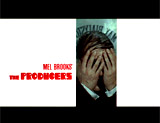

The Producers (1968), 88 minutes, D: Mel Brooks
Director Mel Brooks' debut film is a zany, often brilliant spoof comedy about Broadway productions and the Nazis that some consider in bad taste. A desperate, bankrupt, wild-eyed, hustling Broadway producer Max Bialystock (Zero Mostel) greedily pairs up with his timid and high-strung auditor/accountant Leo Bloom (Gene Wilder in his first starring role). Together, they concoct an illegal 'sure-fire' scheme to make a million dollars from investors by producing the worst, most tasteless play ever made - a perverted Busby Berkeley romp offensively named Springtime For Hitler. Their plan backfires when the flop is actually a surprise hit. Although certain elements are now tame and have lost some comedic shock value since the late 60s, such as a cash-strapped Max being a gigolo for old ladies, the film is still daring, audacious and subversive. The lighthearted satire of Hitler, reminiscent of Chaplin's The Great Dictator (1940), with such lyrics as "Don't be stupid, be a smarty -- come and join the Nazi Party!" couldn't easily be produced today. (The studio would never have released Brooks' film without the intervention of Peter Sellers, who convinced executive producer Joseph E. Levine to release it, the only compromise being a change from the original title Springtime For Hitler to The Producers.)

Rachel, Rachel (1968), 101 minutes, D: Paul Newman
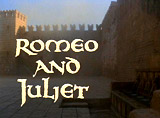


Romeo and Juliet (1968, UK/It.), 138 minutes, D: Franco Zeffirelli
The classic and immortal Shakespearean tale of forbidden, tragic, and star-crossed love. Adapted in this modern and realistic version by Zeffirelli for the first time with two teenaged leads as the youthful, innocent, strong-willed lovers Romeo (Leonard Whiting) and Juliet (Olivia Hussey). Their warring families, the bitterly-hateful Montagues and Capulets, doom their tender romance, with a first-time-ever scene of the nude couple on their wedding night. In gorgeous Technicolor, shot on location in Italy and enhanced by a memorable soundtrack from Nino Rota.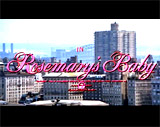


Rosemary's Baby (1968), 136 minutes, D: Roman Polanski
This was Polish director Roman Polanski's first American feature film and his second, scary horror film - following his first disturbing film in English titled Repulsion (1965, UK) - which was also about a mentally-unstable, sexually-terrified woman (Catherine Deneuve) who had been left alone in her apartment. This film was adapted from Ira Levin's best-seller - a convincing, creepy, psychological, Satanist horror/thriller about a young pregnant wife who suspected and had strange premonitions about diabolical forces (a witches' coven) threatening her unborn baby. Young newlywed couple: Rosemary (Mia Farrow) - with a fertile imagination, and aspiring, out-of-work actor/husband Guy Woodhouse (John Cassavetes) moved into a gothic NYC apartment complex in Central Park West. They met their overly-solicitous and intrusive elderly couple next-door neighbors Roman (Sidney Blackmer) and nosy Minnie Castevet (Ruth Gordon), and soon Guy's acting career turned promising. But after a nightmarish dream of making love to a Beast, the paranoid, haunted, and hysterical woman believed herself impregnated not by her husband but by Satan, so that her baby could be used in the New Yorkers' evil cult rituals, with coven members including Roman and Minnie. The creepy film ended with the devil's flesh-and-blood baby in a black-draped cradle, surrounded by coven members. After Rosemary took her first look and her eyes widened in terror ("What have you done to its eyes?"), she began caring for the baby and gently rocked Satan's spawn to sleep. It had effectively made the point that evil surrounds us in the alienated, every-day, mundane city environment.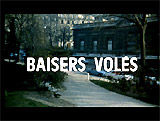


Stolen Kisses (1968, Fr.) (aka Baisers Volés), 90 minutes, D: François Truffaut


The Swimmer (1968), 94 minutes, D: Frank Perry
This was a strange arthouse sleeper film, much neglected and misunderstood when it was first released. The surreal allegorical film about a revelatory mid-life crisis-journey was based upon John Cheever's 1964 short story "The Swimmer." On a sunny summer afternoon, eccentric, middle-aged advertising executive Ned Merrill (Burt Lancaster) impulsively decided to return to his affluent home from a pool cocktail party by 'swimming' the distance of 8 miles. The fit, virile, self-satisfied and tanned Ned was obsessed with the idea of stopping at the homes and pools of friends and neighbors of his upper-class, hollow and soulless Connecticut community along the way, forming a virtual 'river' (dubbed Lucinda's River after his wife) that connected them. Each stop in his journey evoked powerful memories, and revealed more about the self-deluded man's past, distorted memories and disintegrating life - and his inability to face reality. Although nostalgic, he was forced to honestly confront where he was in life. Rather than living an ideal existence, he had become a shallow, dysfunctional and tortured suburbanite who had failed in his personal life. At the Graham's pool, he admitted to an indifferent Betty Graham (Kim Hunter) that he once had a secret love for her. Elderly Mrs. Hammar (Cornelia Otis Skinner) ordered him off her property. In another encounter with nubile 20-year-old ex-babysitter Julie Hooper (Janet Landgard) who joined him for part of his swim, he frightened her away when she revealed a schoolgirl crush on him and he became inappropriately amorous. Others included lonesome and hung-over Joan (Joan Rivers in her film debut), a pair of nudists, and stage actress and miffed ex-mistress Shirley Abbott (Janice Rule) who assaulted him with the truth of their relationship - she never loved him. He was met with hostility and criticized by others for his snobby wife and two out-of-control, estranged unloving daughters. During his last stop after being completely stripped of his protected ego, he arrived during a rainstorm (cold and shivering) at his own empty, locked, deserted and abandoned house - indicative of his recent financial troubles and the real truth about his unraveling broken-down life.
Targets (1968), 90 minutes, D: Peter Bogdanovich
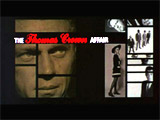

The Thomas Crown Affair (1968), 102 minutes, D: Norman Jewison


2001: A Space Odyssey (1968, UK), 139 minutes, D: Stanley Kubrick
Kubrick's metaphoric, thought-provoking, grandiose, science-fiction landmark film, with space travel to Jupiter, the mysterious appearance of enigmatic monoliths, and the presence of the film's major protagonist - an omniscient super-computer. A three-act, visionary, visually dazzling, wide-screen masterpiece, with mind-blowing special effects. The first monolith appears to prehistoric ape-men, awakening them to the use of tools as killing weapons. Further monoliths on the Moon and floating in space somewhere near Jupiter, seem to coax humankind to make evolutionary leaps and transcend bodily and technological limits. A team of robotic-like astronauts Bowman (Keir Dullea) and Poole (Gary Lockwood), during a voyage to Jupiter to investigate a radio transmission, are terrorized by the arrogant, humanistic, on-board computer HAL 9000 (voice of Douglas Rain). With the mission aborted and following a psychedelic light-show, Bowman is reborn within an embryonic divine life form that floats in space.



Yellow Submarine (1968, UK), 85 minutes, D: George Dunning